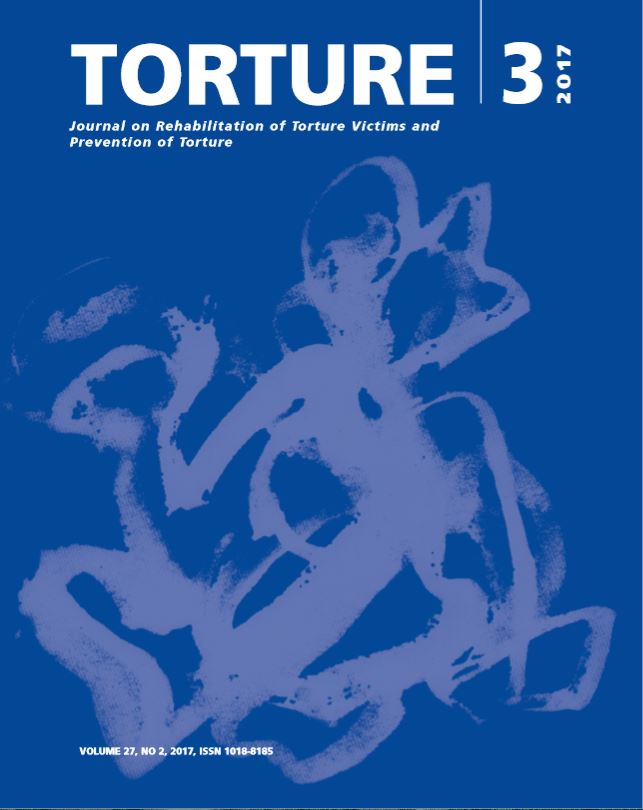Archivos
-
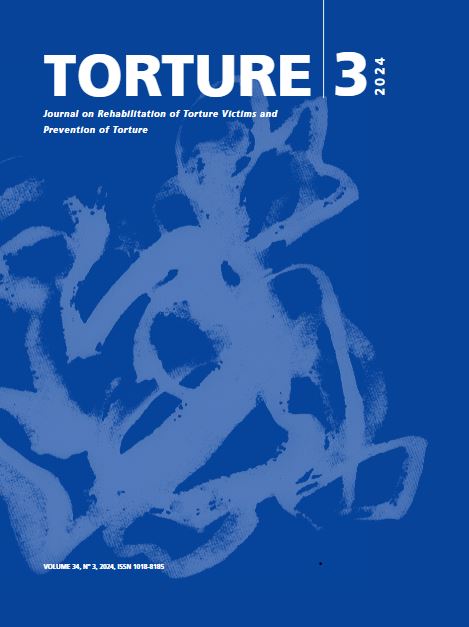
Torture Journal: Journal on Rehabilitation of Torture Victims and Prevention of Torture
Vol. 34 Núm. 3 (2024)The issue opens with an editorial by Pau Perez-Sales and Sara Lopez-Martin, which examines the denial of abortion rights as a form of ill-treatment or torture. Drawing on international human rights jurisprudence, the authors outline how restrictive abortion laws can amount to cruel, inhuman, or degrading treatment, with severe physical and psychological consequences. The piece argues for the decriminalization of abortion and highlights the role of health professionals and legal practitioners in advocating for reproductive rights as part of broader anti-torture efforts.
Catarina Nahlén Bose and Ronak Tamdjidi contribute a systematic review on children who survive torture, focusing on the screening, documentation, and treatment of torture injuries in minors. This paper addresses a gap in existing literature, advocating for tailored approaches to ensure the psychological and physical well-being of child survivors. The authors emphasize the importance of child-specific protocols in torture rehabilitation centres, calling for stronger integration of pediatric care in torture assessment frameworks.
Nudd et al. present a research paper examining the health and legal implications of prison overcrowding. Their analysis highlights the link between overcrowded facilities and increased risks of ill-treatment, proposing legal and public health interventions to mitigate harm. The paper underscores the urgent need for systemic reforms to address prison conditions, recognizing the structural violence embedded within penal systems globally.
In another research contribution, Tinghög et al. explore the acceptability and preliminary effects of intensive trauma-focused PTSD treatment for refugees. Through a pilot study, the authors assess the outcomes of short-term interventions aimed at alleviating trauma symptoms. Early results suggest that such treatments can be effective in improving psychological well-being, though the study notes the importance of long-term follow-up to fully evaluate the impact of these interventions.
Anne Margrethe Sønneland contributes with an article which delves into the experiences of survivors rebuilding their lives after torture. Through narrative reconstruction, Sønneland explores the long-term social and emotional consequences of torture, shedding light on the resilience of survivors and the barriers they face in reclaiming their futures.
Berta Soley and Hugo Marboeuf discuss the implementation of the IRCT Global Standards on Rehabilitation of Torture Survivors through a piece that traces the path from the adoption of these standards to their practical application in rehabilitation centres worldwide, highlighting key lessons learned and strategies for strengthening the quality of care provided to survivors.
In the news section, Andrea Mølgaard reports on a historic legal victory holding a U.S. contractor accountable for acts of torture at Abu Ghraib prison. The article provides insight into the significance of this verdict for international justice and emphasizes the role of litigation in advancing accountability for torture.
The issue also features a letter to the editor from Anna Fierz, addressing the concerning rise in ocular injuries caused by less-lethal weapons in Switzerland. Fierz draws attention to the disproportionate use of such weapons in protest contexts, advocating for regulatory measures to safeguard civilians from unnecessary harm.
Finally, the issue closes with a call for papers on human rights violations in Israel and Occupied Palestine, encouraging submissions that reflect on the intersection of torture, conflict, and legal accountability in the region.
-
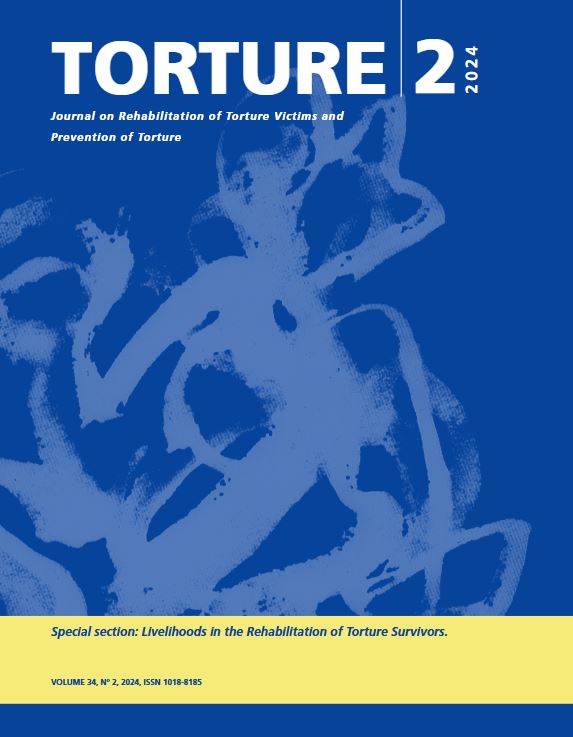
Torture Journal: Journal on Rehabilitaiton of Torture Victims and Prevention of Torture
Vol. 34 Núm. 2 (2024)This issue is introduced by the Editorial, which outlines key considerations for cross-cultural assessments of torture survivors, covering concepts from anthropology, medicine, psychology, and psychiatry, and reviews the most relevant elements of a forensic report, focusing on cultural and ethical aspects of the Istanbul Protocol, addressing interviews, medical exams, and psychological evaluations, with attention to transcultural views on pain.
This issue includes a special section with contributions that explore the integration of livelihoods in the rehabilitation of torture survivors. Starting with a paper from Tania Herbert examining the intersect between livelihoods loss and torture, the importance of documenting livelihoods losses in torture assessments and the integration of livelihoods into rehabilitation programs. It provides a foundational framework for treatment centres to consider the integration of socio-economic support into rehabilitation programmes, in addition to psychological and medical care, to address the full impact of torture. The author advocates for a survivor-centered, evidence-based approach to restore sustainable livelihoods as part of comprehensive treatment efforts.
Berta Soley and Skyla Park present a paper which examines the short-term outcomes of five projects that integrate livelihoods support with mental health and psychosocial treatment for survivors of torture. These projects, conducted by IRCT member centers in Uganda, India, Lebanon, Nepal, and Palestine, aimed to enhance rehabilitation outcomes by addressing both socio-economic and psychological needs. The study’s preliminary results suggest that integrating livelihoods into rehabilitation improved participants’ well-being, social relationships, and community integration. However, limitations such as small sample sizes and short project durations make the results preliminary, highlighting the need for further research.
This is followed by a contribution by Khanal and colleagues, from one of the centres included in the study by Soley and Parks, assessing the outcomes of integrating livelihood support into mental health and psychosocial support (MHPSS) programs for survivors of torture in western Nepal. Results show reductions in anxiety, depression, and PTSD, as well as increased self-confidence, social trust, and economic resilience. The study emphasizes the importance of a holistic approach to rehabilitation, integrating livelihood support to enhance the well-being and social reintegration of torture survivors.
Likewise, Ayesha Mushtaq explores the integration of livelihood support with MHPSS in the rehabilitation of torture survivors in low- and middle-income countries (LMICs). Using a cross-sectional study, it highlights the negative cycle of poverty and mental health faced by survivors, with 92% of respondents confirming a strong link between the two. The integration of livelihood support is found to improve mental health outcomes, economic stability, and social reintegration. The study further recommends enhancing coordination, securing sustainable funding, and implementing holistic rehabilitation programs to address survivors’ needs comprehensively.
The special section concludes with the contribution from Andreea Lachsz, which studies the incarcerated populations in Australia and the US, highlighting how many come from marginalized communities with histories of trauma, arguing that imprisonment adds to this trauma and calls for a shift in the criminal legal system from focusing on reducing reoffending to promoting healing. The author also advocates for stronger international legal protections and more research into the effectiveness of prison labour in supporting post-release livelihoods.
This issue also includes a research paper from Nielsen and colleagues that assesses the effectiveness of sleep-enhancing treatments, Imagery Rehearsal Therapy (IRT) and mianserin in trauma-affected refugees with PTSD. The study finds that IRT improved well-being six months post-treatment, but neither IRT nor mianserin showed significant benefits in sleep quality or other outcomes compared to TAU.
-
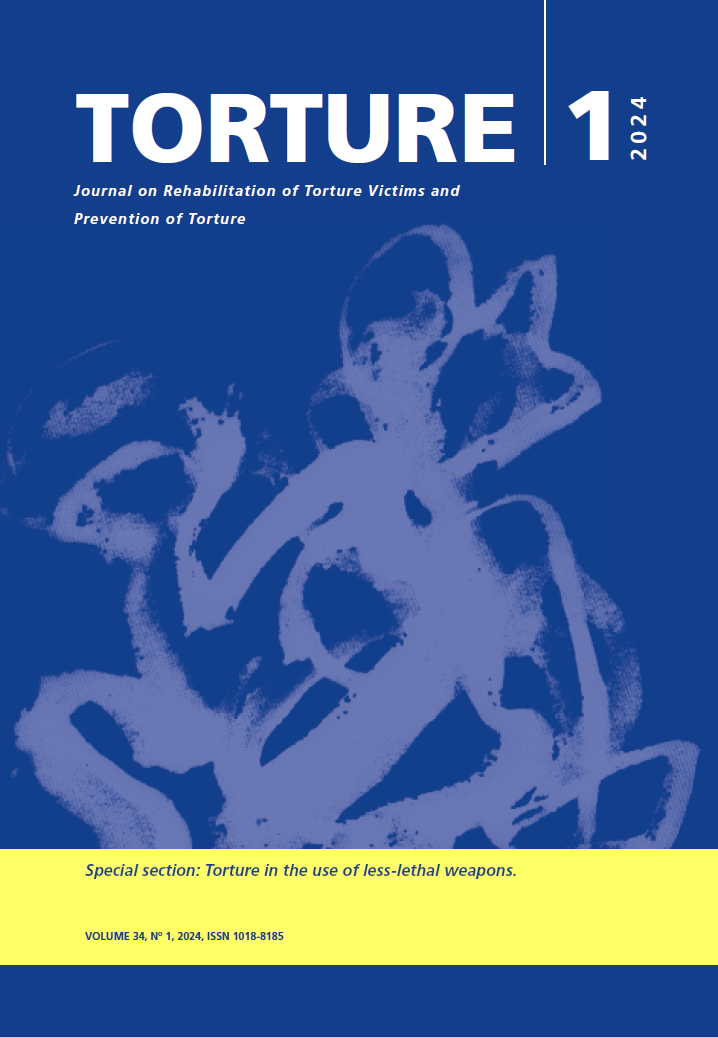
Torture Journal: Journal on Rehabilitaiton of Torture Victims and Prevention of Torture
Vol. 34 Núm. 1 (2024)This issue features a special section on the use of less lethal weapons and in particular the use of kinetic energy projectiles as a form of ill-treatment or torture.
Pau Pérez-Sales introduces this issue with an Editorial that reviews the specificities and complexities of strategic litigation in the cases of ocular injuries by less-lethal weapons, with a focus on the challenges of collecting evidence during and after the injury event, building on the Istanbul Protocol's medical and psychiatric assessments. It also explores possible litigation venues for human rights organisations and provides guidance on the ophthalmological, medical, psychological, psychometric and psychosocial aspects of evidence-gathering.
Matthew McEvoy, Neil Corney, Marina Parras and Rohini Haar present a comprehensive review of the state of the art from a medico-legal perspective based on Omega Foundation’s experience.
The UN Special Rapporteur on Torture, Alice Edwards, recalls from her recent report to the UN General Assembly the existence of instruments that are inherently constitutive of torture concerning the use of less lethal weapons, and calls, in her contribution to the Journal, for their international prohibition.
Marie Brasholt and the Dignity medical team present a comprehensive review based on case studies published in the literature on the health impacts of electric shock weapons. This goes hand in hand with the Editorial, which comprehensively reviews elements related to the litigation of cases and, especially, the forensic assessment of eye injuries based on the Istanbul Protocol.
The reviews are followed by case studies with articles by Malose Langa and colleagues (South Africa), Jose Tejada and colleagues (Chile), Anaïs Franquesa and colleagues (Spain), and the MOCAO survivor’s organisation (Colombia). These contributions reflect the perspectives of the survivors and the enormous legal, medical and psychosocial difficulties faced by victims in all these countries.
In the Perspectives section, Carles Guillot provides a first-person testimony of his struggle as a victim of traumatic eye injury and the endeavours of the collective he represents.
Within the regular articles section, Jörg Alfred Stippel presents a review of cases of ill-treatment and torture in the Chilean penal system and Justine Dee a review of evidence-based physical therapies in torture survivors.
Finally, the issue closes with a couple of contributions on the situation of solitary confinement in Turkey based on a visit of a delegation of experts to the country, the situation of the high-security internationally contested prison system in El Salvador by Professor Lutz Oette, the situation of mentally ill persons in prisons in Kosovo by Niman Hajdari, and a letter by Andres Gautier on the situation in the occupied territories of Palestine.
The use of less lethal weapons as a form of ill-treatment or torture is probably one of the most comprehensive and complex issues to have emerged in the field in recent years and we are proud of the important role played by survivors in many of the articles we publish: Undoubtedly a distinct element that we want to maintain and enhance in the future. -
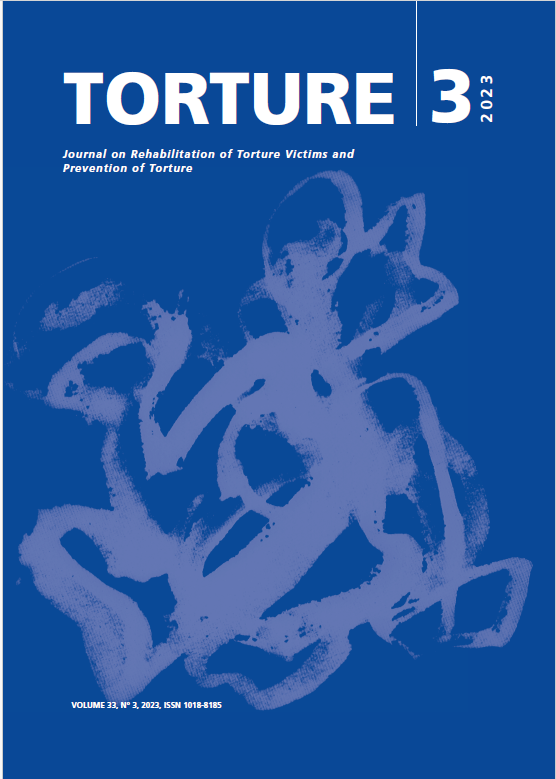
Torture Journal: Journal on Rehabilitaiton of Torture Victims and Prevention of Torture
Vol. 33 Núm. 3 (2023)We take a look at the Russian invasion of Ukraine. Jana Javakhishvili introduces the concept of “substitutive trauma,” which refers to the utilisation of unprocessed collective traumatic experiences by political leadership to create shared feelings of victimhood and vengeful attitudes within a population. The analysis explores how a substitutive trauma-based psycho-political dynamic culminated in February 2022 in Russia’s war against Ukraine. The article argues that the community of traumatic stress professionals, studying and understanding macro-societal processes, can contribute to reducing and ameliorating such destructive psycho-political developments. Most of Jana’s reasonings can surely by applied to the situation in Gaza.
Lopatina et al., present an analysis of the impact of the Russian occupation on the activities of Berdyansk State Pedagogical University in Ukraine, explaining the different challenges faced by the university community under occupation, particularly emphasising human rights violations and academic freedom and institutional resilience mechanisms to manage to maintain classes despite the invasion.
In a qualitative study with survivors and legal practitioners, Rud et al. also present data on resilience, but in this case of victims of torture in Russia. They analyse law enforcement institutions and ways they challenge an individual’s resilience as torturing environments and how it is faced, regardless of the vulnerabilities of the individual, their social status and institutional context. It is a path-breaking study that provides fresh perspectives on a subject that has been scarcely addressed in the anti-torture field.
Also on resilience in torture survivors is the editorial, with reflections, learnings and ways forward in a field that lacks more scientific research.
The issue also addresses the topic of torturing environments. Alejandro Forero’s paper reviews prison overcrowding as ill-treatment or torture under international law, focusing on three aspects: minimum standards with respect to living space, the use of tools to establish the existence of harm caused by inhuman conditions of incarceration and some corrective, restorative measures for prisoners that innovative jurisprudence is introducing.
Stroppa presents the work of Physicians for Human Rights Israel and Antigone on an International Guiding Statement of Alternatives to Solitary Confinement, proposing global guidelines for reducing and overcoming the use of solitary confinement in prisons.
Finally, a research study presented by Barbieri et al. examines the prevalence of hallucinations in a sample of treatment-seeking trauma-affected refugees. It analyses the relative role of torture and some other interpersonal traumatic events (i.e., imprisonment, sexual assault, non-sexual assault) as well as PTSD severity and a range of socio-demographic variables in the emergence of hallucinations.
Additionally, Castilla conducts a brief review of the recently published General Comment No.1 of the Committee against Forced Disappearances in the context of migration as a new opportunity to re-humanise the management of migrations in all regions of the world.
-
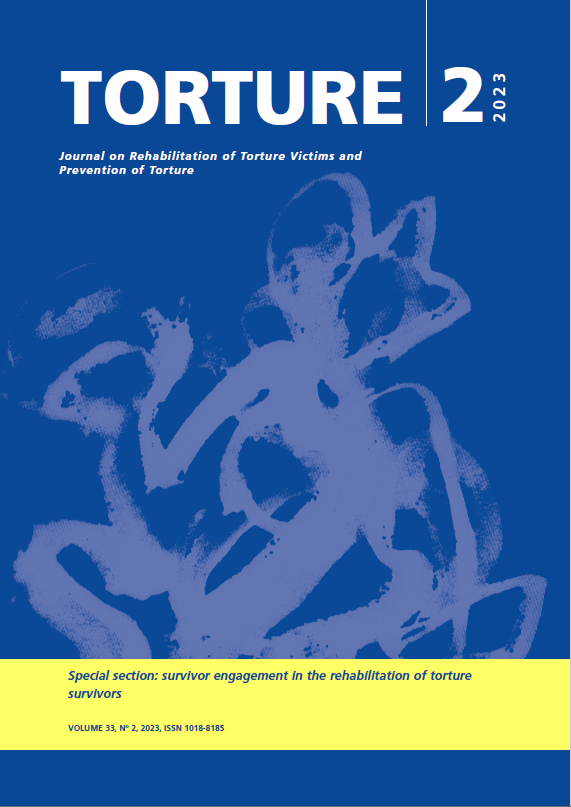
Torture Journal: Journal on Rehabilitaiton of Torture Victims and Prevention of Torture
Vol. 33 Núm. 2 (2023)Pau Pérez-Sales introduces this issue with an Editorial that provides us with a background of the origins of survivor engagement being historically implemented in the Global South.
The Editorial is followed by the Special Section on Survivor Engagement in the Rehabilitation of Torture Survivors.
Susan Wyatt opens the section with a paper that reflects on the notions of restoring power or ‘agency’ to survivors, discussing different conceptual frameworks and pathways for effective and strategic mechanisms for facilitating ‘agency’ within the spectrum of torture rehabilitation.
Einolf et al. presents a qualitative study that explores current practices, best practices, and the advantages and disadvantages of engaging survivors in the direction and provision of rehabilitation services. It discusses the risks of re-traumatization and presents practices that involve engaging survivors in ways that do not instigate their trauma.
Moreover, Mikel Soto, presents the survivor-lead experience of the Network of Tortured People of Navarre and analyses the keys to this process of collective empowerment, describing the self-organising process of the victims and some lessons that may be useful for other realities and groups of torture victims who want to engage in self-organising processes.
Henceforth, Seini O’Connor and colleagues contribute to the special section with three articles. The first one describes TASSC’s model for engaging survivors in advocacy and presents evidence on the personal impacts such engagement can have. The second one looks at the characteristics of survivors who engage in advocacy in comparison with those who do not. The third one explores survivor engagement in the form of cultural facilitation, drawing on a case example of cultural bridging involving a pilot programme to train torture survivors and former refugees to become cross-cultural facilitators supporting mental health services for displaced communities.
The special section is closed with the contribution from Rachel Hoare, further expanding on the benefits of the befriending programme within Spirasi’s holistic approach and the importance of collaborative expressive arts activities in building befriending relationships. She does that through an empirical study that explores, in complementary ways, the impact of this befriending programme on befrienders and befriendees and incorporates their voices into recommendations for optimising the service.
The perspective section, entails three contributions.
José Quiroga and Ana Deutsch share their personal memories to describe and reconstruct the journey to the development of forensic torture assessment tools, before the existence of the Istanbul Protocol. They review the historical precedents of the Forensic Assessment of Torture Survivors in the US in the 1970s and 1980s, the first model of affidavit developed in Los Angeles, setting the precedents of the US branch of the construction of the Istanbul Protocol that was developed in the late 1990s.
Christian DeVos and colleagues explore extra-carceral governmental actions that constitute torture or ill treatment of socially and economically marginalized populations, advocating for a more contextual approach to the understanding of what constitutes torture or ill treatment, and, consequently, a more expansive interpretation of states’ obligations to prohibit and prevent it under international law. Building on examples that unsettle the conventional understanding of torture focused on carceral and custodial settings, they also offer recommendations for how clinicians and health and human rights researchers, can better elucidate the links among torture, poverty, and vulnerability to hold perpetrators accountable and help states develop laws, policies, and other measures to prevent the perpetration of state-promoted or sanctioned acts of torture or ill treatment.
Daniel Weishut and colleagues present their insights about the use of the Istanbul Protocol in Israel, as collected by a group of experts in the documentation of torture and ill-treatment, at the reception of the revised (2022) version.
This is followed by a book review by Giulia Berta of the volume Migration and Torture in Today’s World, curated by Fabio Perocco and published by Ca’ Foscari Editions in 2023.
This issue also announces Dr. Mahmud Sehwail’s paper “Personal reflection” as the winner of the 2022 CTI Prize, after being the most voted by the IRCT membership and the Torture Journal readership. Congratulations, Dr. Mahmud!
Finally, this issue is concluded with the forthcoming call for papers for the special sections on Livelihoods and Prisons, in which we encourage you all to submit papers, in case you have relevant research and/or experiences to share in these areas.
You, the readers and authors, are responsible for the increasing growth of Torture Journal: a home for all.
We would like to especially thank the authors for their excellent work and contribution to the Torture Journal, and OSSTT and STARTTS for their valuable continued support.
-

Torture Journal: Journal on Rehabilitation of Torture Victims and Prevention of Torture
Vol. 33 Núm. 1 (2023)What can you find in this issue?
Pau Pérez-Sales and Paula de la Fuente introduce this issue with a quick guide on detection and assessment of victims of torture and ill-treatment in Primary Health Care, incorporating the last advancements of the 2022 Istanbul Protocol.
The Editorial is followed by a section compiling research articles.
Jesús Silva presents a study that describes and classifies the type of torture and ill-treatment in the orofacial area of victims of political repression during the Chilean military dictatorship and relates them to the injuries registered in written reports. It also draws on the psychological impact for victims.
Andrea Galán et al., introduce an exploratory study on the quality of forensic assessments using the Istanbul Protocol in a virtual versus face-to-face environment, through which they assess the advantages and disadvantages of online methodologies for forensic assessments.
İlker Özyıldırım and colleagues, contribute with a study that assesses the effectiveness of psychoanalytic psychotherapy in patients with PTSD as a results of torture and severe human rights violations.
Following these studies, this issue compiles three contributions that conform a special section on forensic documentation of psychological torture.
Given the difficulty to legally substantiate and establish harms produces by threatening acts, as well as to clearly identify the harms that go beyond the fear and stress inherent (hence, unlawful) in law enforcement practices, Pau Pérez-Sales et al. present a Protocol on medico-legal documentation of threats to enhance documentation and assessment of harms so that stronger legal claims can be submitted to local and international complaint mechanisms.
Jane Kilpatrick et al., review the definition and the spectrum of deprivation of sunlight as a method of torture, drawing on the harms caused by this practice that may amount to torture.
Marie Brasholt and colleagues close the special section with the presentation of a Protocol on medico-legal documentation of solitary confinement which seeks to improve documentation of solitary confinement and, hence, to clarify the facts of the case so that stronger legal claims can subsequently be submitted to local and international complaints mechanisms.
In our continuous education section, Olivia Febles Simeon and C. Nicholas Cuneo present the case of MA, a case of a survivor of labour trafficking, kidnapping, and sexual violence in her home country; to demonstrate the value of remote evaluations conducted by health professionals for the purpose of applying for humanitarian parole and prioritizing the most vulnerable cases.
This issue also contains a thematic briefing summarising the key findings and recommendations to the United Nations Working Group following the official presentation of the monographic issue on Enforced Disappearances as Torture in Geneva, together with OMCT, on the 22nd of September.
Moreover, we celebrate the new appointment of our fellow board member, Dr. Alice Edwards, as the new Special Rapporteur against Torture. In this issue, in addition to welcoming her appointment, we include an article written by herself discussing her priorities during her tenure and the role of the Torture Journal.
Finally, this issue also includes the forthcoming call for papers for three special sections on Survivor Engagement, Livelihoods and Prisons, in which we encourage you all to submit papers, in case you have relevant research and/or experiences to share in these areas.
You, the readers and authors, are responsible for the increasing growth of Torture Journal: a home for all.
We would like to especially thank the authors for their excellent work and contribution to the Torture Journal, and OSSTT and STARTTS for their valuable continued support.
-
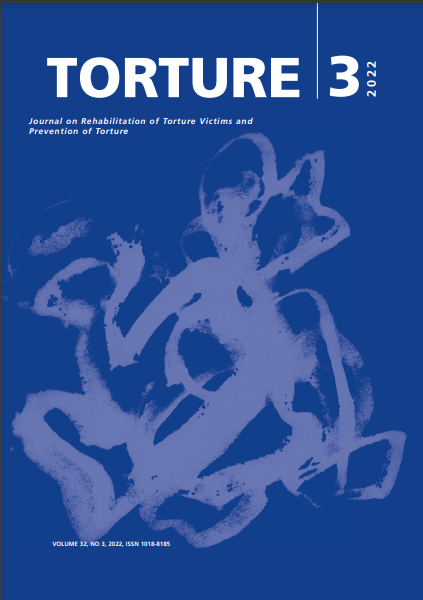
Torture Journal: Journal on Rehabilitation of Torture Victims and Prevention of Torture
Vol. 32 Núm. 3 (2022)This issue introduces the revised edition of the Istanbul Protocol. The Editorial offers a summarised guide that outlines the new elements and main variations of the recently launched 2022-version. You will find it available in English, French and Spanish.
The contribution from Ergun Cakal opens the scientific section of this issue, presenting a doctrinal review which consolidates normative understandings of adequate prisoner food. His paper discusses the aspects relevant to assessing when and how food provision is considered inadequate through a systematic exploration of international and regional standards.
Phyu Pannu et al. continue exploring resilience-promoting factors for refugees who have survived torture to understand how these impact the relationship between torture and mental health.
Aaron Gallagher et al. present a student-run clinical study to investigate the changes in asylum seekers’ profile over 3 years. They argue that understanding background and trauma profile of newly displaced populations is fundamental to meet their health needs and integration.
The section Perspectives compiles two papers. In the first one, Daniel J. N. Weishut discusses the potential participation of psychologists in IP-based physical examinations as it elaborates on the author’s perspective as clinical psychologist and relevant literature. In the second one, Maria Hartwig and Mark Fallon argue that the American government’s post 9-11 torture program was a big deceit, in that the designers, executors and enablers knew all along that torture does not elicit reliable information. The authors review the government’s own research and discuss the ways in which methods known to be unreliable were implemented, most saliently at the detention facility at Guantánamo Bay, against international law and human rights.
The Continuous education section includes a case where Cynthia Luo et al. argue the limitations of administering psychological surveys implying the development of ways to identify, mitigate and overcome such limitations.
In our News section, we celebrate the launch of the 2022-revised version of the Istanbul Protocol.
Finally, this issue includes the forthcoming call for papers for two special sections on survivors engagement and livelihoods in rehabilitation, in which we encourage you all to submit papers, in case you have relevant research and/or experiences to share in these areas.
-
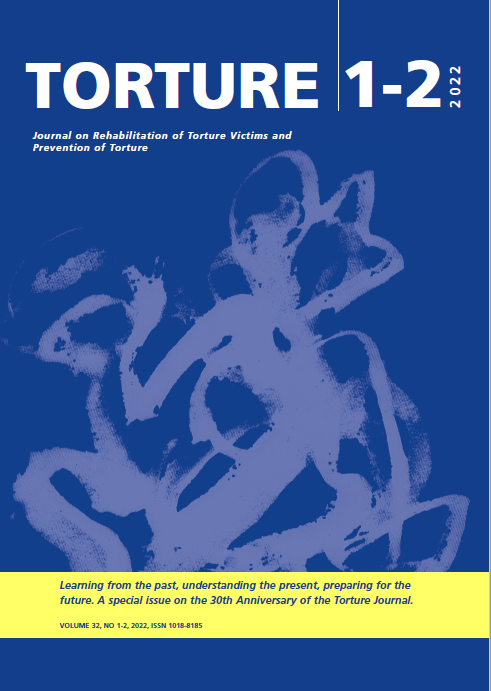
Torture Journal: Journal on Rehabilitation of Torture Victims and Prevention of Torture
Vol. 32 Núm. 1-2 (2022)This is an outstanding double-issue which celebrates the 30 years of the Torture Journal through commemorative contributions from authors who have had a long trajectory in the fight against torture or accompanied the evolution of the Journal.
This valuable collection of 25 papers represents different perspectives - from the anthropological to the epidemiological, the legal to the clinical - on how authors have experienced this journey.
The double issue is divided into three sections: 1) Learning from the past; 2) Understanding the present; and 3) Preparing for the future.
The first section is essential reading for anyone who wants to understand the history and viewpoints of the many individuals who have gathered around and contributed to the Torture Journal. It includes contributions from Hans Draminsky Petersen, Mahmud Sewail, June Pagaduan Lopez, Inger Agger, Vincent Iacopino, Henrik Døcker, Christian Pross, Peter Vesti, Diana Kordon and Darío Lagos, José Quiroga and Elizabeth Lira, Jorge Aroche and Mariano Coello, and Lilla Hárdi. The second section reflects on the present with contributions from Sharon Shalev, Edith Montgomery, Michael Wessells, Nora Sveaass and Felice Gaer, Stephen Soldz, and Masha Lisitsyna. And the third section explores the future with papers from Derrick Silove, Nimisha Patel and Amanda Williams, Metin Başoğlu, Tony Reeler, Carlos Madariaga, Stuart Turner and Pau Pérez-Sales.
All in all, this unique issue is a modest illustration of the plurality of voices that have found their space in the Torture Journal and represents the many challenges we have overcome together over the past 30 years while acknowledging the vitality of a field that has countless challenges still to face.
Finally, this issue also includes the forthcoming call for papers for two special sections on survivor engagement and livelihoods in the rehabilitation of torture survivors, in which we encourage you all to submit papers, in case you have relevant research and/or experiences to share in these areas.
-
Torture Journal: Journal on Rehabilitation of Torture Victims and Prevention of Torture
Vol. 31 Núm. 3 (2021)In the celebration of the journal’s 30th anniversary and pending the publication of the Special -Commemorative issue, this last number of 2021 has two Special Sections.
On the one hand, the second part of the section on Enforced Disappearance as Torture published in our previous issue is complemented by four additional papers: Natalia Huerta and Edith Escareño examine the case of the 43 students who disappeared in Ayotzinapa (Mexico) in 2014. How the Mexican state’s mistreatment suffered by the survivors and their families has provoked elements of suffering that the authors consider amounting to ill-treatment or torture. Anne Margrethe Sønneland publishes the results of several years of research with witnesses and victims of the trials of perpetrators of enforced disappearance in Argentina, pointing out those elements that could constitute elements of re-traumatisation or additional suffering adding to previous burdens. Mayra Eliana Nuñez analyses the decreasing role of relatives and witnesses in legal proceedings for enforced disappearance before the Inter-American Court of Human Rights. In an overburdened court, neither experts nor victims are allowed to speak. The process before the Court is progressively becoming more of a legal dialogue between the parties, while experts and victims are relegated to add through documentary contributions. In the authors’ opinion, this means that much of the reparatory value of the Court over the suffering of the victims is lost. Finally, Vesna Stefanovska reflects on the El Masri judgement in the European Court of Human Rights and its relevance for victims of enforced disappearance.
The author elaborates on previous literature stating that cases of Extraordinary Rendition constitute forms of enforced disappearance and should be treated as such by international jurisprudence.On the other hand, this issue includes a Special Section on dental care for torture survivors with two papers that complement each other. According to epidemiological data, about 35% of torture victims have suffered trauma to their mouth or teeth. Anne Catrin Høyvik and colleagues conducted a qualitative study with 10 torture survivors from different cultural backgrounds attending dental facilities. Karlsson and colleagues conducted semi-structured interviews with dentists and professionals from rehabilitation centres in Norway. Together, the two studies provide a unique perspective on the difficulties and risks of re-traumatisation of victims and the low detection capacity and knowledge
of the professionals who should care for them. Important policy recommendations emerge from both studies. Aisling Hearns and collaborators present a validation study of the International Trauma Questionnaire as an instrument for the early detection of Complex Posttraumatic Stress (CPTSD). Their data support the idea that PTSD and CPTSD are distinct entities and that both should be detected in torture survivors attending rehabilitation centres.Alongside this is the continuing education section, which discusses the forensic documentation of electric shocks as a form of torture. We want to pay an extraordinary tribute to Dr June P. Lopez, a founding member of the IRCT and a key figure in the fight against torture in recent decades, who passed away this month. Along with an obituary by Dr Aurora Parong, friend and fellow, we include the text of an essay that Dr June Lopez was writing for the 30th anniversary of the Journal. Although she considered it an unfinished text, we have decided to publish it as the best tribute to a tireless fighter who leaves behind an indelible mark.
-

Torture Journal: Journal on Rehabilitation of Torture Victims and Prevention of Torture
Vol. 31 Núm. 2 (2021)Presentamos en este Número 2021/2 los primeros 6 aportes de la sección especial sobre desaparición forzada como tortura, mientras que los 4 restantes aparecerán en el Número 2021/3. Agradecemos a los Guest Editors, Bernard Duhaime y Mariana Castilla, que han contribuido enormemente a esta sección especial de desapariciones forzadas.
Manon Bourguignon y col. analizan cómo experimentan el duelo las víctimas de tales crímenes que se enfrentan sin cesar a la incertidumbre y la impunidad exacerbada. Realiza un análisis comparativo de las diferentes conceptualizaciones utilizadas para describir el duelo de los familiares y propone elementos clave que son comunes a todos ellos.
Nicolás Morales aborda el impacto de las inadecuadas investigaciones y medidas de reparación por desapariciones forzadas, ocurridas en la región de Paine, en Chile, durante la dictadura de Pinochet. Destaca la importancia de las vivencias en primera persona de los familiares de desaparecidos que permitan dar cuenta de la dimensión subjetiva y colectiva de la identificación forense. También analiza la importancia de comprender mejor los impactos intergeneracionales de tales delitos.
El concepto de victimización es analizado por Mina Rauschenbach et al. en su estudio sobre el reconocimiento de la condición de víctimas en El Salvador y en Colombia, dos países en los que se han producido desapariciones forzadas de forma masiva durante los conflictos armados internos. Considera cómo ese estatus se define legalmente en ambos países y cómo impacta sus experiencias en el sistema judicial.
Alejandra Vicente y Eva Nudd examinan la importancia del fenómeno de las desapariciones en África, una región donde este crimen no se denuncia. Los autores también describen los debates actuales sostenidos por la Comisión Africana de Derechos Humanos y de los Pueblos sobre el tema, en particular la evolución del proyecto de directrices sobre desapariciones forzadas en África que está elaborando actualmente el Grupo de Trabajo de la Comisión sobre Pena de Muerte, Extrajudicial, Resumen o asesinatos arbitrarios y desapariciones forzadas.
Aïcha Madi presenta un estudio de caso de desapariciones forzadas en Argelia que muestra que el impacto atraviesa más de una generación y permanece como una herida oculta en la sociedad que debe ser abordada por todos los actores políticos.
La contribución de Inamul Haq analiza cómo las desapariciones forzadas han afectado a las mujeres en Cachemira, más específicamente cómo estas últimas han sido marginadas como "medio viudas", sin las medidas de rehabilitación adecuadas para abordar el trauma emocional y psicológico que enfrentan a diario.
Este número también incluye tres artículos científicos regulares que no forman parte de la sección especial. Ebbe Munk-Andersen y col. presentan los resultados positivos de un cuestionario estructurado utilizado para seleccionar a los solicitantes de asilo en Dinamarca, Dongmi Kim et al. revisar la eficacia de la farmacoterapia para el trastorno depresivo mayor y el trastorno de estrés postraumático por tortura, mostrando la falta de pruebas sólidas para cualquiera de los tratamientos propuestos. Karen Fondacaro et al. publicaron en 2018 en Torture Journal un artículo que explica el marco de estrés traumático crónico como modelo conceptual para guiar la investigación empírica y el tratamiento de salud mental para refugiados y sobrevivientes de tortura. En este número, complementan ese artículo con un segundo artículo sobre el tratamiento del estrés traumático crónico.
Además, es un gran placer dar la bienvenida a la Serie de Casos Forenses, una nueva sección del Torture Journal editada por Ben McVane y James Lin. Los casos de esta sección pueden describir
los hallazgos físicos y psicológicos únicos o poco comunes, ilustran las barreras para una evaluación completa o presentan características que dificultan la articulación efectiva de la afirmación de un sobreviviente. Las discusiones de casos tienen como objetivo proporcionar más información sobre los hallazgos o reflexiones sobre cómo se abordaron los desafíos. También tienen como objetivo abordar los conceptos erróneos comunes sobre la evaluación clínica y la experiencia de la tortura.En total, esto hace 160 páginas, el número más largo en la historia de la Revista. Ustedes, lectores y autores, son responsables del creciente crecimiento de Torture Journal: un hogar para todos.
-
Torture: Journal on Rehabilitation of Torture Victims and Prevention of Torture
Vol. 31 Núm. 1 (2021)Pau Pérez-Sales introduces this issue with an Editorial which conceptualises and documents threats in the context of ill-treatment and torture. He provides a theoretical reflection on what threats are, what types exist and how they impact the survivor from a medical and psychological perspective, providing a framework of understanding that will hopefully improve conceptual and practical assessment, documentation and qualification.
Ergün Cakal continues with a discussion on the characterisation of threats as psychological torture in international law. His paper suggests that an assessment of the perception of practice and proximity of state authorities to harm could help qualify such threats as torturous.
This issue continues with the contribution from Nicholas Nelson et al. who present a cross-sectional study on patterns of torture among forcibly displaced Eritrean men in the US. This is the first study of its kind and provides valuable data on prevalent methods, and clinical impacts in a sample of 59 survivors assessed using the Istanbul Protocol.
Following the call for contributions from the Journal, Juliet Cohen et al. present preliminary data on remote medico-legal assessment by telephone during Covid-19, showing that it can be safely used with some special considerations assessed in the paper. We are now expecting results from the comparison with the video assessment.
Vipin Vijay et al. present a qualitative study on the experiences of survivors of commercial sexual exploitation at RP homes in India with an analysis of the elements that facilitate the rehabilitation according to the vice of survivors.
The paper by Frank Hofmann et al. describes the implementation of a pilot project on the use of EMDR in children in post-conflict settings conducted in Northern Iraq.
The IRCT conducted an open discussion on Survivor Engagement in the work of Rehabilitation Centers for torture survivors. Berta Soley has summarised the conclusions and included an interview with Lynne Walker that shares how the Tree of Life Trust has incorporated this perspective for more than ten years.
This issue also includes the Letter to the Editor by Jesús Antona which exposes the proneness of Chilean democracy, exposing the Catrillanca case and the Temucuicui community arrest.
In recent months, during a year when organisations that provide services for survivors of torture faced new challenges during the global COVID-19 pandemic, some of the people who have been leading the anti-torture movement for years have passed. We have paid tribute to Javier Enriquez Sam (1960-2021), Gerald “Jerry” Gray (1935-2020), Sister Jean Abbott (1943-2021), Jose María “Chato” Galante (1948-2020), Gianfranco De Maio (1963-2020) and Sister Dianna Ortiz (1958-2021). Many more people have left us in these months, but let the testimony of Javier, Jerry, Jean, Chato, Gianfranco and Dianna serve as a tribute. They have left behind them a light that we will try to follow.
Finally, this issue also includes the forthcoming call for papers for the special section on racism, ethnocentrism and torture by police and security services.
-
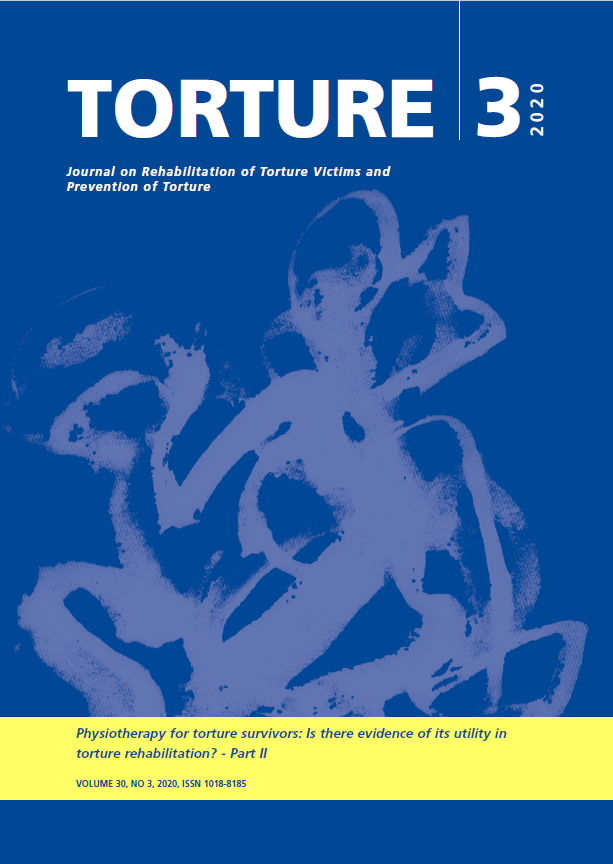
Journal on Rehabilitation of Torture Victims and Prevention of Torture
Vol. 30 Núm. 3 (2020)This issue of Torture Journal initiates with an Editorial by Pau Pérez-Sales, Editor-in-Chief, which examines the state of the art of deprivation and manipulation of food as a torture method.
This edition includes the second part of the Special Section on Physiotherapy in work with torture survivors.
Laura Pizer Gueron and MaryAnn de Ruiter present the results of a survey conducted among professionals worldwide regarding the availability and use of physiotherapy services with torture survivors. The same team presents the development and detailed explanation of, and initial assessment data from the Group Physiotherapy Model with torture survivors that has been developed by the Center for Victims of Torture. Anne-Mette Karrer et al. present an evaluation of the cultural acceptability and feasibility of a School Pain Treatment programme for populations affected by trauma in Arab countries. Finally Marie Nordheim Alme et al. describe the PREP programme; international experience of collaboration in training processes for physiotherapists working with torture victims.
This number also comprises regular articles in which Marta Guarch-Rubio et al. present worrying data on the prevalence of situations of ill-treatment or torture of asylum seekers arriving to Serbia. Moa Nyamwathi Lønning et al. present a nation-wide study on public rehabilitation systems for torture victims in Norway, and Maria-Angeliki Psyrraki et al. present a study carried out in Athens on the concept of rehabilitation and the importance of mutual support networks in the Congolese refugee population.
The issue concludes with a book review, and a letter to the editor.
-
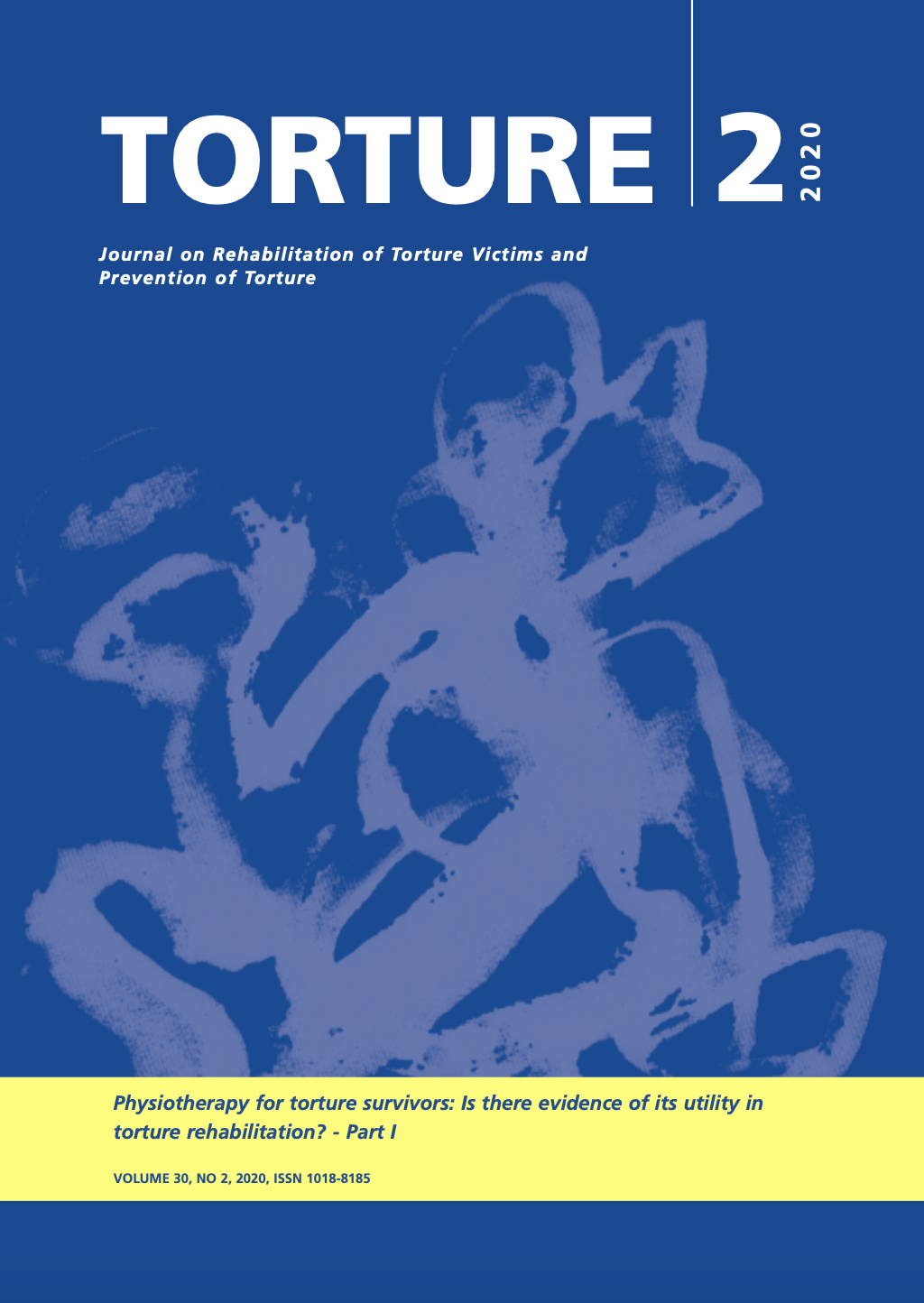
Journal on Rehabilitation of Torture Victims and Prevention of Torture
Vol. 30 Núm. 2 (2020)In this issue, the Editorial reviews the effects of COVID-19 on torture survivors and their communities.
This issue also includes Part I of a Special Section on Physiotherapy as Torture. Under the Special Section:
Iselin Dibaj, Joar Halvorsen, Leif Ottesen Kennair and Håkon Stenmark contribute a narrative review on challenges in trauma-focused therapy for torture survivors with PTSD and chronic pain, showing that there is still not enough support for the widely accepted assumption that addressing trauma can improve chronic pain. April Gamble, Salah Hassan Rahim, Ahmed M. Amin Ahmed and Jeff Hartman present the results of a pilot study on the Effects of a Combined Psychotherapy and Physiotherapy Group Treatment Program for Survivors of Torture with very preliminary, although promising results. Tanju Bahrilli and Hamiyet Yüce present a study on Basic Body Awareness Therapy in hunger strike victims with Wernicke Korsakoff Syndrome, showing improvement in different quality of life indicators in survivors that had been severely handicapped for years.
Additionally, Paula Suárez-López presents a review on the potential of epigenetic methods to provide evidence of torture. Genetic markers, now still at an early stage of development, show enormous potential to detect long-term and trans-generational impacts of chronic trauma in general.
Marie Brasholt, Brenda van den Bergh, Erinda Bllaca, Alba Mejía, Marie My Warborg Larsen, Anne Katrine Graudal Levinsen, and Jens Modvig present results on a study conducted in Albania and Honduras on the risk of sanctions following visits by monitoring bodies to detention centers, that shows that this is a relevant and neglected area in the prevention of torture. The results are alarming and show that a very significant percentage of people interviewed suffer some kind of harassment or reprisal following the visits.
This issue includes a Debate in which, Sara López poses the complex question: What are the ethical dilemmas and proposed criteria when a (potential) perpetrator asks for forensic documentation of their own alleged torture. The author proposes three criteria that can be applied by forensic experts and organizations. Four expert authors, Juliet Cohen, Elizabeth Lira, Henry Shue and Onder Ozkalipci, provide insights on the proposal with a final wrap-up and answer from the author.
-
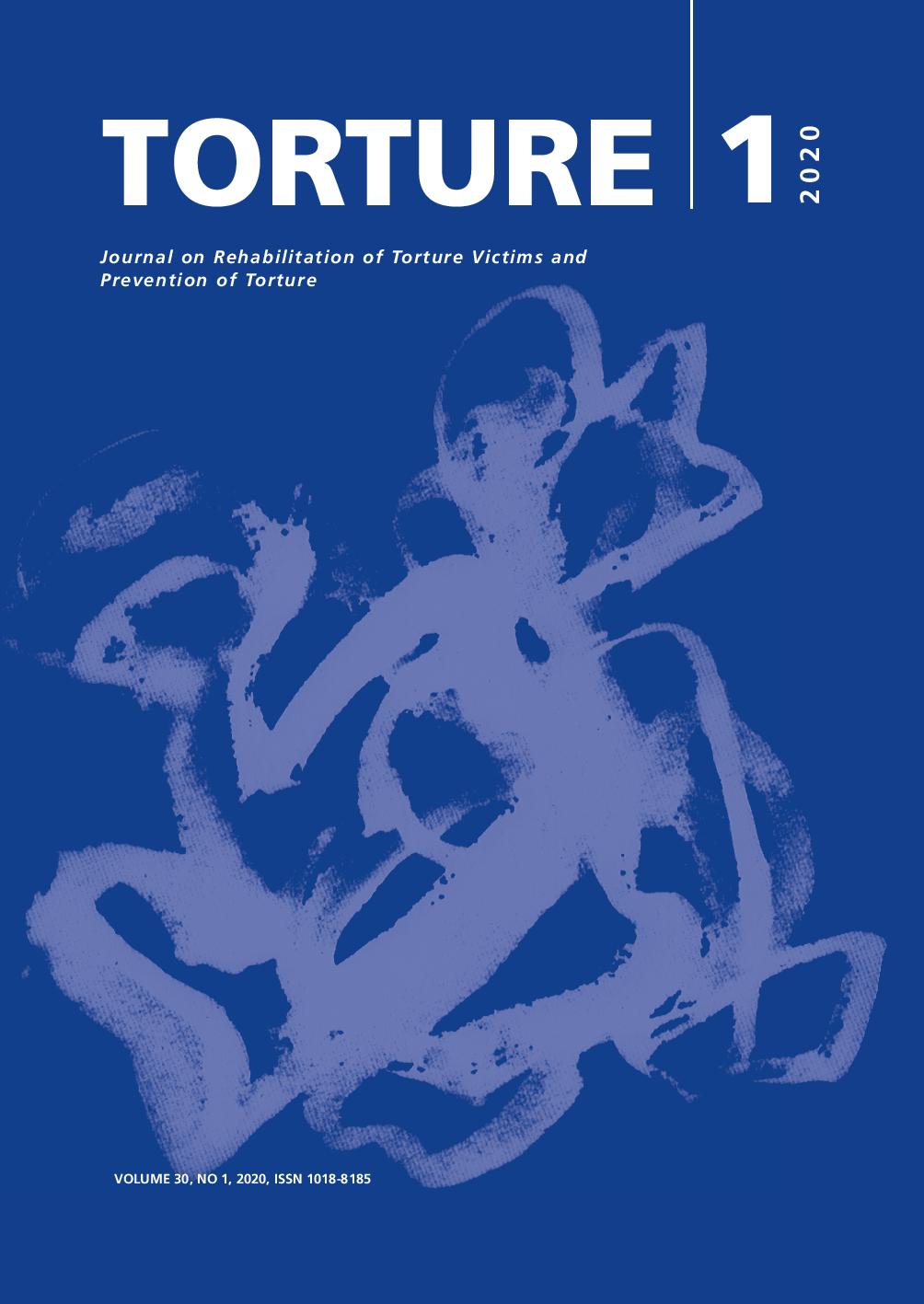
Journal on Rehabilitation of Torture Victims and Prevention of Torture
Vol. 30 Núm. 1 (2020)Scientific contributions in this issue include presentation of a Complex Care Approach (CCA) for treatment of torture victims that integrates medical, psychological, psychosocial and existential elements from a holistic perspective, and apply it to an hypothetical paradigmatic case. A short scientific report presents a series of 40 cases of male victims of sexual torture in India with severe urological sequelae in defining the concept of parrilla torture and showing the interplay between medical and psychological sequels.
This issue also includes a short research report that presents data from an early analysis of the safeguards in the medical examination of people detained in Catalonia (Spain) in the framework of civic protests. The analysis serves as a reminder that the ethical principles of the Istanbul Protocol must be respected in all circumstances. Their data evidences a request for more thorough investigation by the Spanish authorities.
Conversion therapies are still common practice in many countries around the world as a recent IRCT report has shown. The Independent Forensic Expert Group (IFEG) has been working over the past two years on an analysis of these practices as a form of ill-treatment or torture. The reader will find a landmark document: the IFEG's latest Statement with the conclusions and recommendations to the international legal and medical communities.
Johan Lansen, one of the great European figures of the 20th century in the work with torture survivors, from his own experience as a Holocaust survivor, passed away in November 2019. Torture Journal reprints, as a posthu- mous tribute, the article that he published in the Journal of Medical Ethics more than 15 years ago with personal reflections on the ethical dilemmas of working with perpetrators.
This issue also presents the challenging path to criminalisation of torture and enforced disappearances in Thailand that has been ongoing for over a decade. The Special Suppression and Prevention and of Torture and Enforced Disappearance Bill, introduced in 2014 remains entangled in the Thai legislative process.
-
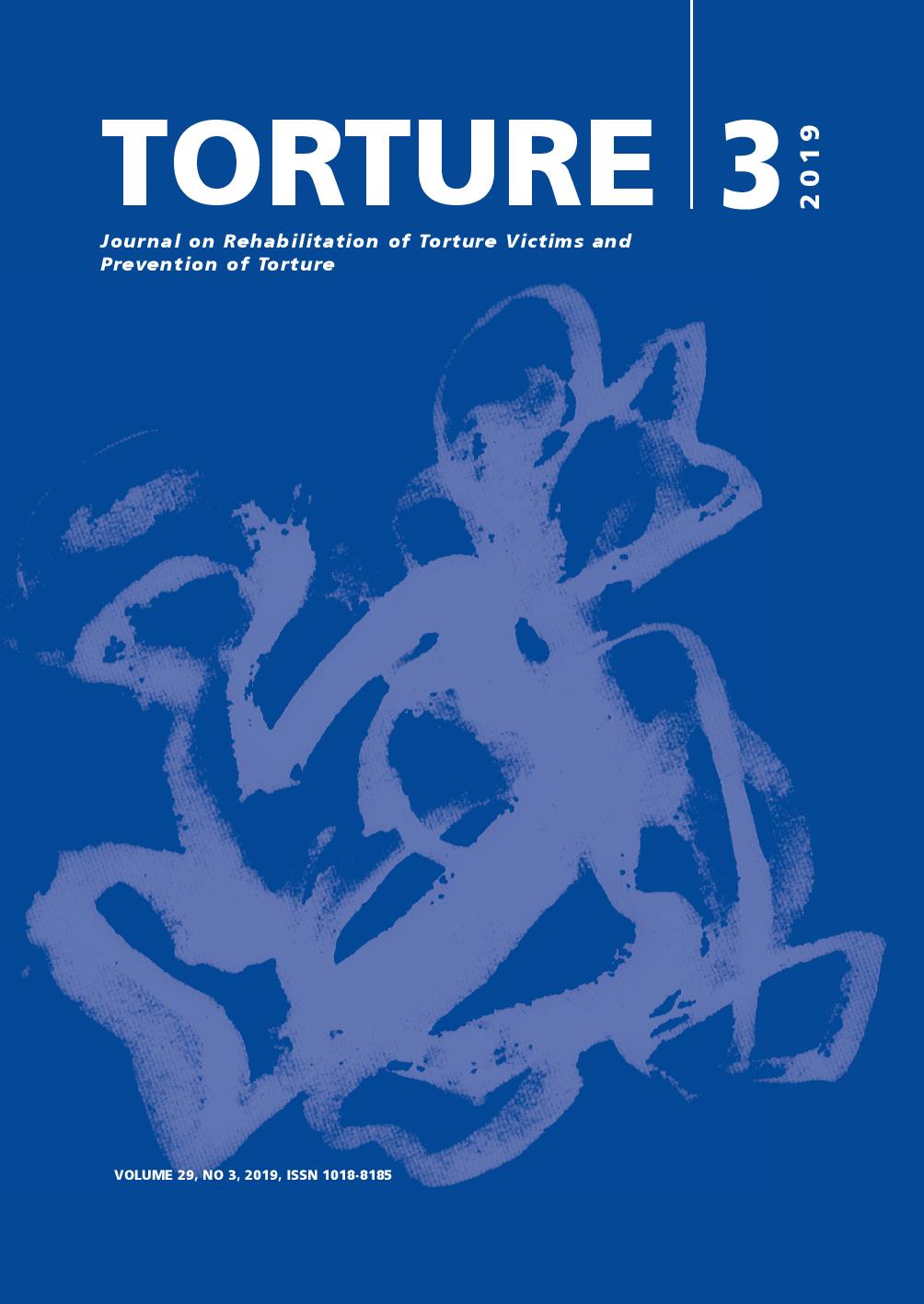
Journal on Rehabilitation of Torture Victims and Prevention of Torture
Vol. 29 Núm. 3 (2019)This issue of the Torture Journal takes its focus on measuring torture rehabilitation processes and results. Scientific contributions on this subject include a measurement of rehabilitation outcomes with an instrument designed at the Marjorie Kovler Center in Chicago; a validation study examining diagnoses of Post-Traumatic Stress Disorder (PTSD) and Complex Post-Traumatic Stress Disorder (CPTSD) in refugee and torture survivor populations; and a study of gender-based violence in Honduras, El Salvador and Guatemala.
The issue also comprises an applied perspective on organizational development in torture rehabilitation programs and two letters to the editor addressing involvement of medical personnel in torture in Syria and a response to the concept of psychological torture.
Finally, Secretary-General of the International Rehabilitation Council for Torture Victims, Lisa Henry, and Chief Executive Officer of STARTTS Centre in Australia, Jorge Aroche, provide an open letter to the Torture Journal readers and a celebratory text of STARTTS' 30th anniversary respectively.
A corrigendum is added to correct the Editorial of Vol. 29 (2).
-
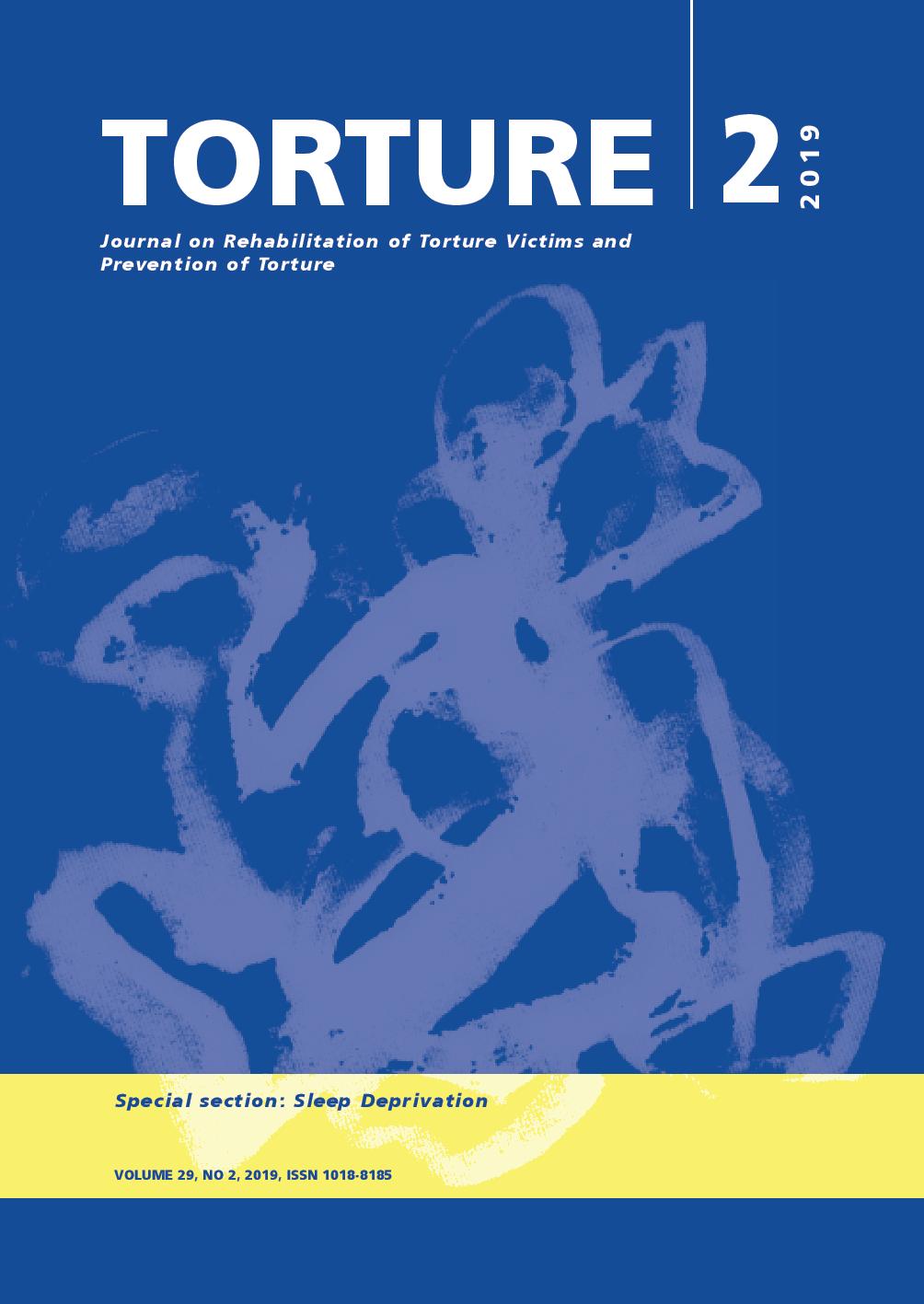
Torture Journal: Journal on Rehabilitation of Torture Victims and Prevention of Torture
Vol. 29 Núm. 2 (2019)This issue of the Torture Journal examines sleep deprivation as a method of torture. The editorial proposes that intentionally forcing a person to have less than 6 hours of continuous, restful sleep must be considered a form of degrading treatment that could amount to cruel and inhuman treatment, and suggests that when daily sleep deprivation is intentionally prolonged in a sustained manner for three days or more, it should be considered as a form of torture in itself.
The issue includes a review of the prohibition of sleep deprivation as torture or ill-treatment in international law and the text of a Protocol for Medico-Legal Documentation of Sleep Deprivation with an accompanying explanatory article covering the development and pilot testing of the Protocol. The section also includes a study carried out in Palestine, documenting the impact of sleep deprivation on a sample of Palestinian detainees.
The issue is further complemented by an epidemiological study on knowledge relating to torture amongst medical professionals in Tanzania and a case report from Australia exemplifying narratives of Tamil survivors of sexual violence. A Debate section that discusses the standing of the Istanbul Protocol through the case of Mr Firas Tbeish is also included. Finally, a book review and letter to the editor close the issue.
-
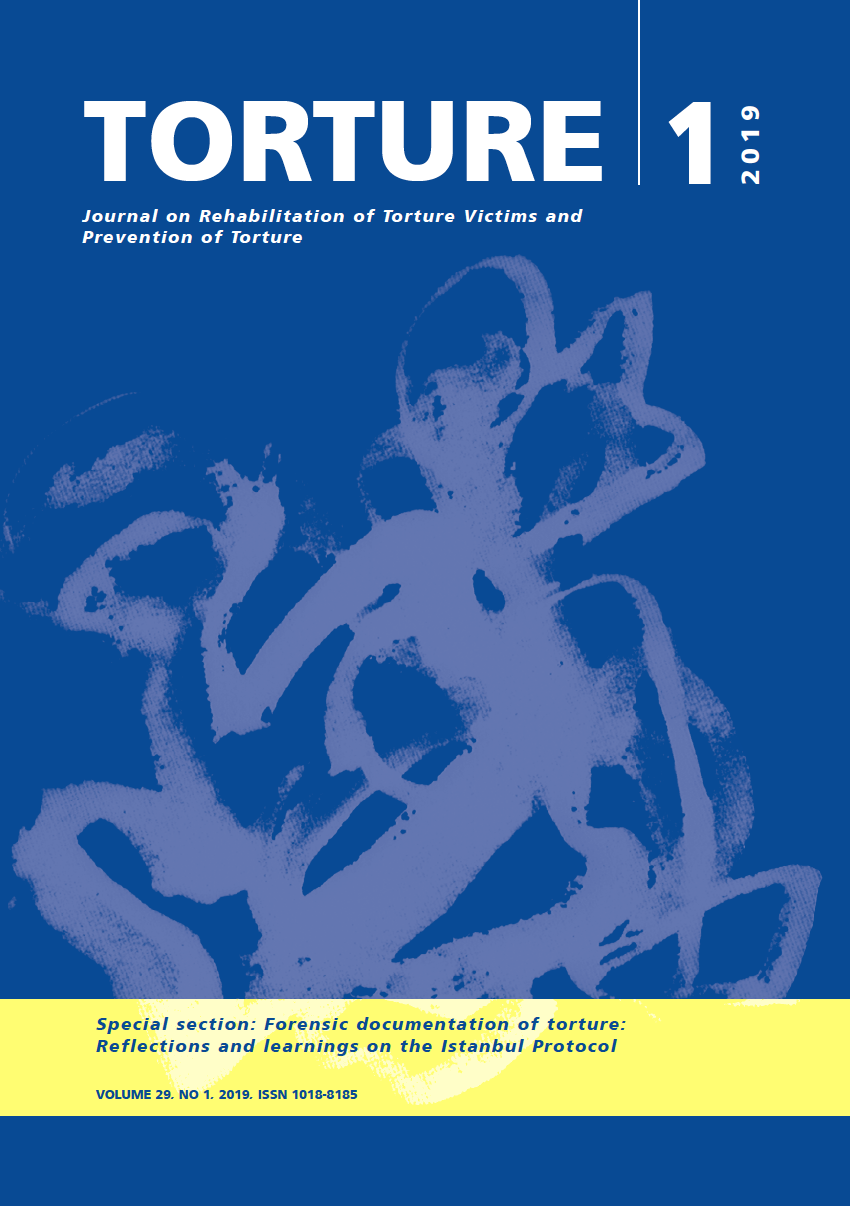
Torture Journal: Journal on Rehabilitation of Torture Victims and Prevention of Torture
Vol. 29 Núm. 1 (2019)This issue of the Torture Journal reveals new, innovative insights on torture documentation and rehabilitation approaches from leading academics and researchers globally. The focus of the latest issue is on forensic documentation of torture. The issue explores documentation in detail regarding its strengths, limitations and innovative new ideas, such as documentation procedures among specific sub-groups. Fresh research and perspectives on sport-based rehabilitation, as well as other key topics, also comprise the issue.
-
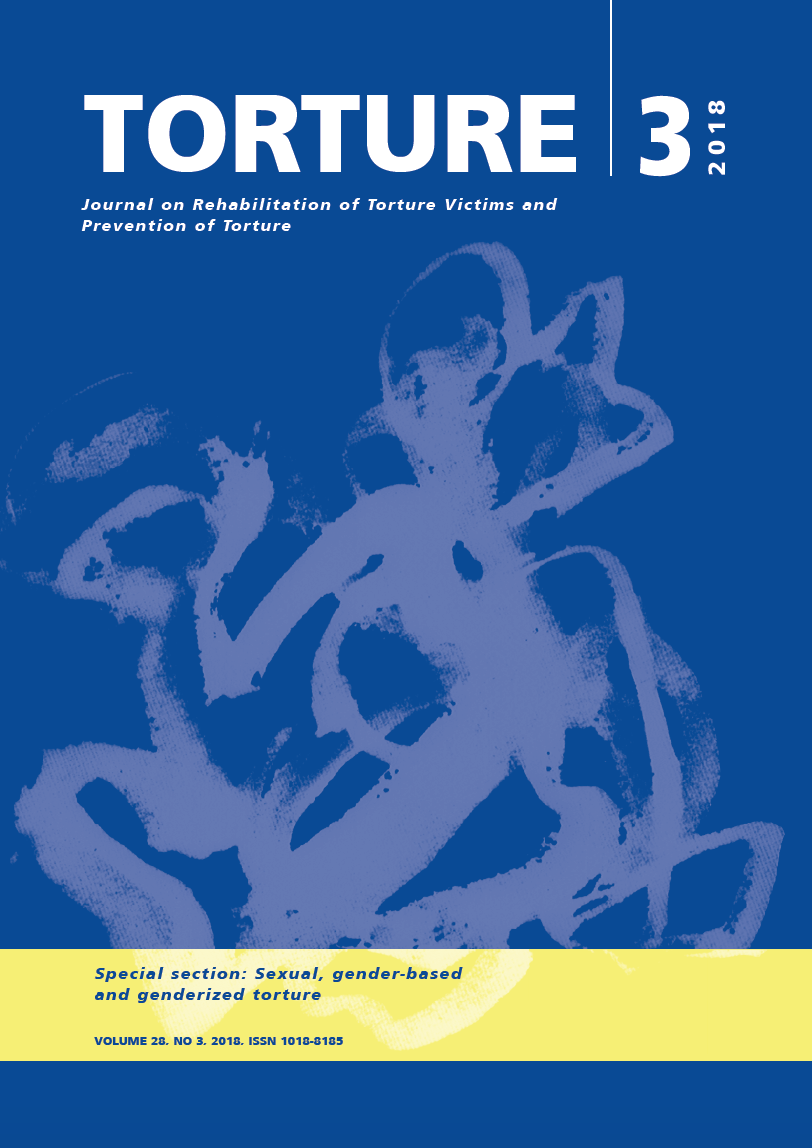
Torture Journal: Journal on Rehabilitation of Torture Victims and Prevention of Torture
Vol. 28 Núm. 3 (2018)This issue of the Torture Journal examines the impact of sexual torture (and other forms of torture) in diverse settings around the world and identifies innovative and culturally appropriate rehabilitation approaches. The issue includes a special section on sexual, gender-based and genderized torture.
-
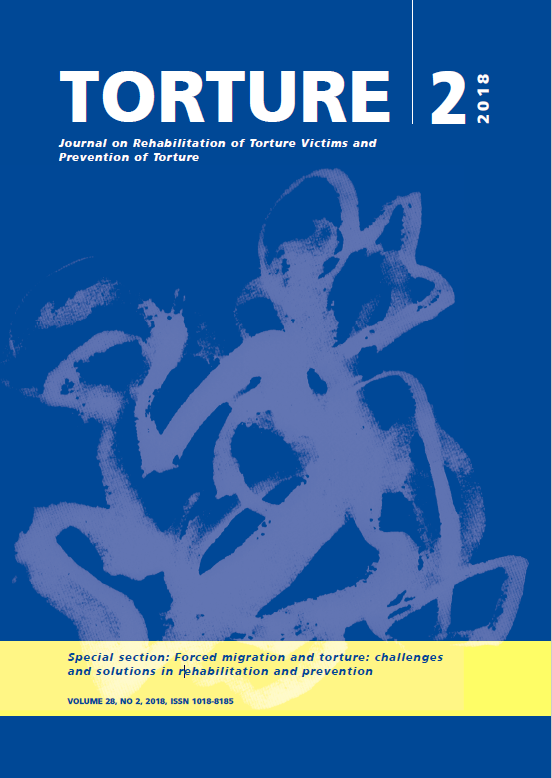
Torture Journal: Journal on Rehabilitation of Torture Victims and Prevention of Torture
Vol. 28 Núm. 2 (2018)Special section: Forced migration and torture: challenges and solutions in rehabilitation and prevention
Forced migration leads to many challenges for rehabilitating torture victims. Challenges and solutions in the forced migration context are investigated and addressed in the latest informative issue of the Torture Journal.
-
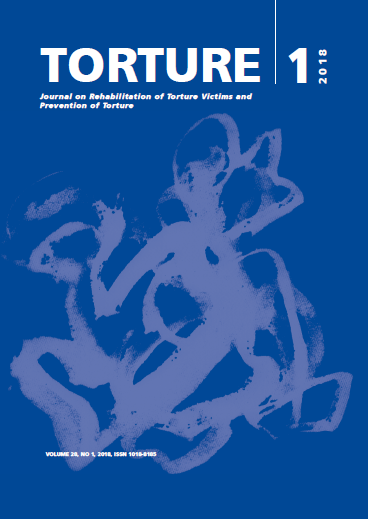
Torture Journal: Journal on Rehabilitation of Torture Victims and Prevention of Torture
Vol. 28 Núm. 1 (2018) -
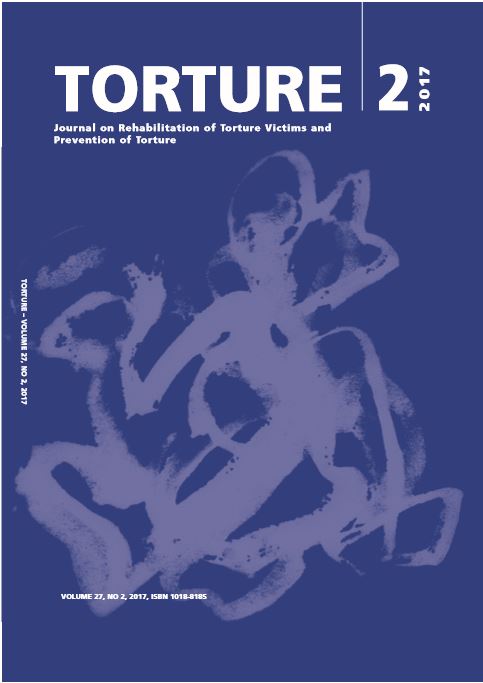
Torture Journal: Journal on Rehabilitation of Torture Victims and Prevention of Torture
Vol. 27 Núm. 2 (2017) -
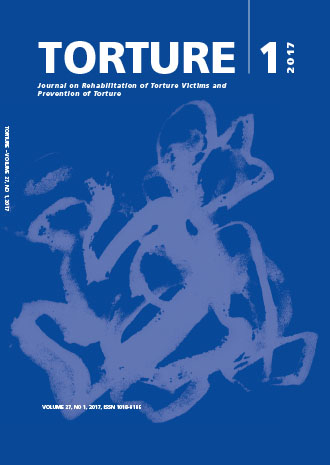
Torture: Journal on Rehabilitation of Torture Victims and Prevention of Torture
Vol. 27 Núm. 1 (2017) -
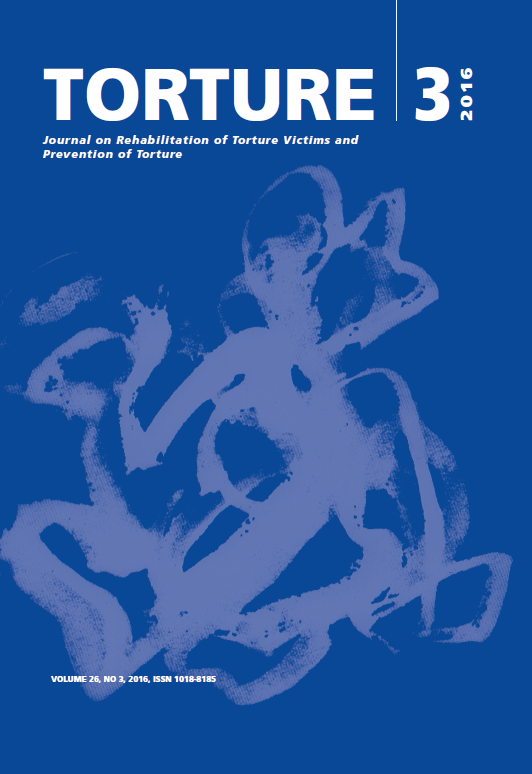
Torture Journal: Journal on Rehabilitation of Torture Victims and Prevention of Torture
Vol. 26 Núm. 3 (2016) -
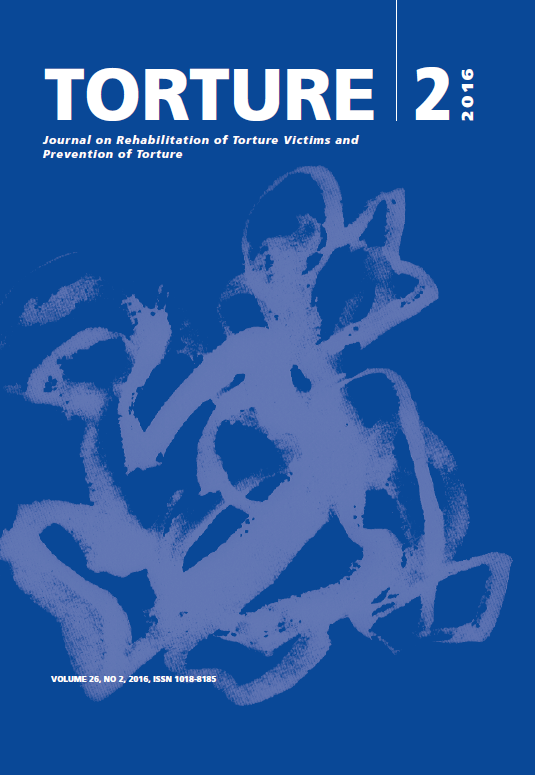
Torture Journal: Journal on Rehabilitation of Torture Victims and Prevention of Torture
Vol. 26 Núm. 2 (2016)Long-running themes and previous research are given new life in this issue, Lilla Hárdi's last as Editor in Chief.

